You are using an out of date browser. It may not display this or other websites correctly.
You should upgrade or use an alternative browser.
You should upgrade or use an alternative browser.
Boldly Going: A History of an American Space Station
- Thread starter e of pi
- Start date
Threadmarks
View all 43 threadmarks
Reader mode
Reader mode
Recent threadmarks
Part 32: The headaches and hassles of developing the next generation of reusable systems - Diana & Shuttle II Part 33: First and Last. Enterprise outlasts its sisters. Shuttle-II flight tests and epilogue. author's note: e of pi author's note: TimothyC Author's Notes: Vehicle Names Author's Notes: World Space Programs Author's Notes: Disposition of Shuttle Program Hardware 2022 Turtledove Win ThanksI read that the character was named for the astronaut
I have to say that, while I am enjoying the heck out of this timeline, I am struggling to accept the plausibility of the speed of Kepler's development schedule.
Even with reliable funding, I was expecting they'd be lucky to have an orbital test flight before the end of the decade.
Even with reliable funding, I was expecting they'd be lucky to have an orbital test flight before the end of the decade.
ESA gives the authorization to proceed in 1987, with significant studies completed beforehand. By 1991, when things are finalized for Enterprise and Minerva, the program is already 4 years into its preparations for flight. (The "option A" delay or elimination of the expanded station which was used to justify Kepler over Hermes in 1989, two years into the capsule program, is part of France's frustration that drives them to Mir--imagine if we pulled out of Gateway today, or worse yet in about 12 months.) The Kepler-D1 and Kepler-D2 debut missions come in 1994, 7 years after program start. The first operational flight is in 1995, 8 years after program start. As a comparison, Dragon was authorized under COTS in 2006, made its first flight in 2010, and was at the station in 2012. Starliner, for all its delays, is still clocking in under a decade from the time commercial crew was properly funded. Kepler-E as a lifeboat has no need for abort tests, reduced requirements for autopilot, reduced required endurance and redundancy in crew support systems, and more. To put it another way which might more directly address your concern, Kepler isn't Orion, and it's still not lunar-ready in 1995.I have to say that, while I am enjoying the heck out of this timeline, I am struggling to accept the plausibility of the speed of Kepler's development schedule.
Even with reliable funding, I was expecting they'd be lucky to have an orbital test flight before the end of the decade.
Any plans on Ariane 5 rocket in TL ?
Looking into LRB
Most study goes for payload of 70000 lb. or 31751 kg. for space shuttle into 28° low orbit.
As Shuttle-C version with 2 SSME, it could bring around 100000 lb. or 45359 kg into 28° low orbit
with 3 SSME payload would be 170000 lb. or 77110 kg.
That for 2 LRB, more payload with 4 LRB, need modification on ET to deal with additional stress during Launch and also launch platform modification.
Looking into LRB
Most study goes for payload of 70000 lb. or 31751 kg. for space shuttle into 28° low orbit.
As Shuttle-C version with 2 SSME, it could bring around 100000 lb. or 45359 kg into 28° low orbit
with 3 SSME payload would be 170000 lb. or 77110 kg.
That for 2 LRB, more payload with 4 LRB, need modification on ET to deal with additional stress during Launch and also launch platform modification.
Last edited:
To put it another way which might more directly address your concern, Kepler isn't Orion, and it's still not lunar-ready in 1995.
Thanks kindly for the explanation.
I didn't think it would get underway as soon as 1987, but...
Still seems a bit optimistic to me, but I'll roll with it.
And if Orion's design had been locked in say 2009-ish, and a man rated rocket capable of launching it existed, it probably would have flown by... well, before 2016. Only in the Constellation days was Orion the problem child, with it's ballooning mass requirements, but as I recall even then it was still making it's deadlines as well or better than other parts of the system, i.e. Ares 1.To put it another way which might more directly address your concern, Kepler isn't Orion, and it's still not lunar-ready in 1995.
The past few chapters have been excellent, I've just not had too much to say beyond that because I agree with and love everything.
And if Orion's design had been locked in say 2009-ish, and a man rated rocket capable of launching it existed, it probably would have flown by... well, before 2016.
If you tripled its annual funding up front, maybe.
I mean, as of today, it doesn't even have a docking system or software yet. Those won't be installed until Artemis III.
I think this most recent post is a great example of how the shuttle could be used as a multipurpose cargo vehicle. Could we see a potential decrew of the station as a result of a medical emergency, something that kind of proves the concept of the lifeboat vehicle? As much as we wouldn't want it to happen of course.
Could we see a potential decrew of the station as a result of a medical emergency, something that kind of proves the concept of the lifeboat vehicle?
That's been a risk more than once on ISS, whenever it has been reduced to just one Soyuz on station.
That's one more reason why it is great having Crew Dragon in operation. If someone needs to be rushed back to Earth, you only lose half the crew.
Yeah, but the docking system isn't being left off the first two flights because it isn't ready. The port is just the IDSS, which we know works since it's being used right now on station. It's being left off because the port is heavy, the flights on SLS block 1 are severely mass limited, and there's nothing to dock to anyway. Leaving it off means there's more service module fuel margin, which makes it easier to ensure they come home.I mean, as of today, it doesn't even have a docking system or software yet. Those won't be installed until Artemis III.
Last edited:
Yeah, but the docking system isn't being left off the first two flights because it isn't ready.
I've heard there's till work to be done, but most especially with the docking software.
Part 17: New LOX habitat completed and compared to France’s work with Mir.
Boldly Going Part 17
After taking over command of the station, the second permanent crew of Space Station Enterprise settled into their new home. The work of outfitting the LOX tank continued to consume the crew’s time as a top priority. The early Enterprise expeditions were well-motivated, as they were literally building their new home. Until the new habitat section was complete, they continued to bunk in the Shuttle-adapted sleep stations in OV-101’s middeck, which also served as galley and was home to the station’s only lavatory. This additional space had seemed vast when some expedition crews had previously used them when visiting the station short-term aboard Shuttle flights...when they had the benefits of an entire second Orbiter’s middeck, lavatory, and typically another Spacelab or Spacehab module. With no second orbiter beyond the intertank’s docking hatch, the crew of four had barely more space than any pre-Enterprise Space Shuttle mission, but were now embarked aboard for a mission months in duration. The counterbalance of the massive open LOX tank volume was cited by many of the crew as key ammunition against cabin fever given the cramped confines of their existing habitat in the old orbiter portion of the station, even as it consumed workday after workday.
[Note: Images in this section are rescaled down. Click on them for links to full size]
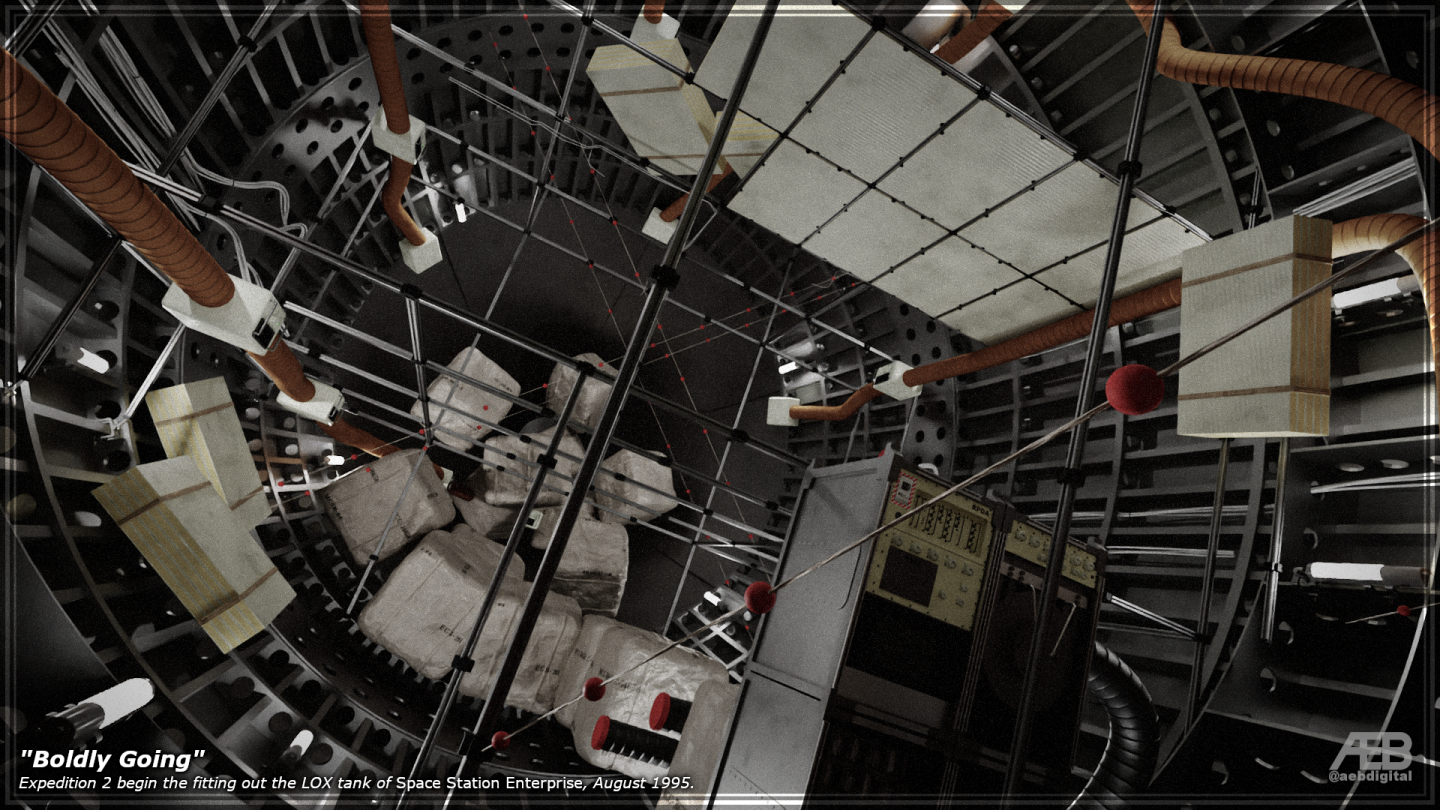
The arrival of STS-83 in June 1996 was a welcome relief for Expedition 2 both from the cramped confines of the primary habitat spaces and from the daily routine of assembling hardware and tracking down loose bolts inside the LOX tank. The orbiter brought with it the first permanent addition to the station, the Japanese-built Node 1 module. Fitted with an APAS port at each end and four radial CBM ports, this module once attached to the nadir port on the station’s intertank would be the core of the nadir ISPR section of the station. There, it would eventually host the new European and Japanese laboratories which were still under construction. In addition to this role in future growth, Node 1 also served a critical immediate need which was highlighted by the complexity of its own arrival. At launch, Space Station Enterprise had just two APAS ports. With one taken up by Shuttle and one by the current Kepler lifeboat, there was neither room to rotate crew return vehicles, nor a place to lock the larger new Multi-Purpose Logistics Modules (MPLMs) which Europe was building for Shuttle logistics flights. In the meantime, Spacelab and the commercial Spacehab modules had to suffice, with cargo brought through the Shuttle’s APAS docking port. The issue was that Shuttles arriving at station docked to the adapter on the same nadir intertank port which Node 1 was intended to dock to. Thus, a complex ballet was required for Challenger to deliver the new Node. Before arriving at the station, Challenger’s crew extracted the node and pre-docked the future zenith end to the Shuttle’s docking port, and then flew the node into docking at the nadir end of the existing adapter in one of the trickier docking maneuvers of the Shuttle program’s history. During STS-83’s short stay on the station, only limited work was done to set up the new module. Once the Shuttle left, Expedition 2 were then free to disconnect the zenith end of the existing adapter from the intertank’s APAS port. Using CanadArm 2, the station then flipped the adapter-and-Node subassembly end-for-end and reattached it. Node 1 was thus in its final configuration, and then the adapter module was detached from Node 1 and flipped again. This complex “Towers of Hanoi” puzzle left the adapter once more right-side-up, but now at the nadir end of Node 1, ready to receive the next orbiter and with 4 more ports open on the sides of Node 1.
[Note: Images in this section are rescaled down. Click on them for links to full size]
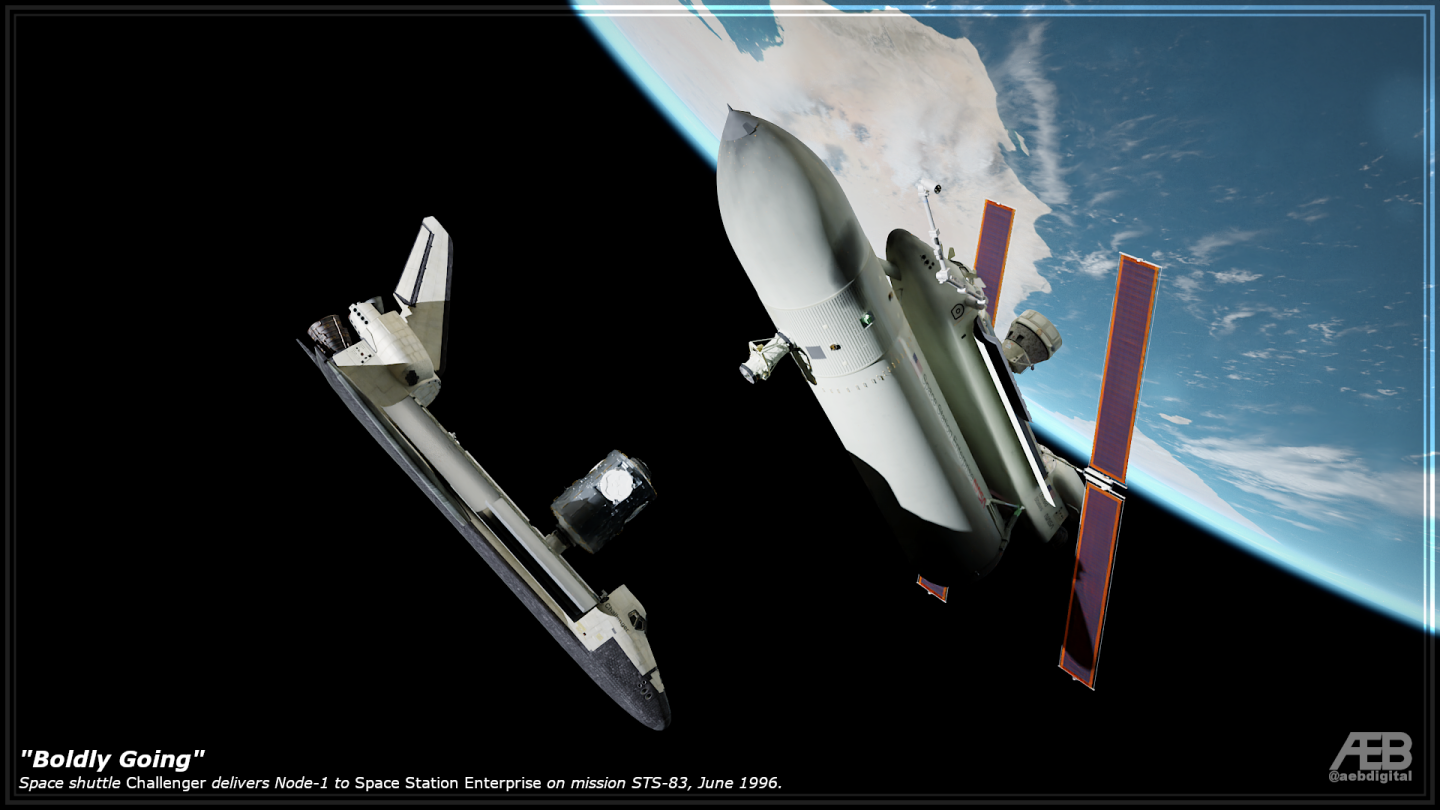

Comparing the relatively small number of crew-hours required to finish installing and outfit the new Node 1 with the much large number required to build the LOX tank habitat in-situ provided major ammunition to those recommending against the incorporation of wet-lab tank adaption into future projects, primarily on the Moon but also for future missions to Mars or beyond. However, advocates of those techniques also pointed out that while the outfitting process would end up consuming the complete attention of five Enterprise Expeditions between August 1995 and May 1997, the result was a station which could barely have been launched any other way. Over roughly a year and a half, the vertical columns and hand-grip wires spanning the cavernous tank had turned into decks, then the framing that defined future walls. Much like building a house on Earth, those frames had been filled by a complex and well-thought-out maze of wiring, plumbing, and ducts. With the labyrinth of utilities installed, the partition walls had been finished by adding their outer foam board and fabric coverings, then stowage racks, equipment bays, and furniture had been installed into the newly divided spaces. By the spring of 1997, the new module’s basic life support systems were active and the crew were sleeping inside the former LOX tank, with the expanded crew quarters allowing Expedition 4 to be augmented to become the first 8-person crew aboard the station with the arrival of four more crew members who would rotate on into Expedition 5. The jump in available hands and the morale benefits of rapidly approaching completion helped accelerate the process, and the work inside the LOX tank was largely done by the time Expedition 5 took over the station in the summer of 1997.
The laborious work of outfitting the Enterprise Habitat Module inside ET-007’s former LOX tank was only part of the work carried out to ready the station for expansion in 1997. In addition to work inside the station’s pressure volume, Expedition 5’s expanded crew also conducted EVAs to run some of the external cabling for the new port and starboard truss modules to their future mounting points on either side of the intertank. This productivity was driven, in part, by the fact that the additional personnel had little scientific work competing for their attention. The station’s lab equipment was still contained in the single Leonardo Lab Module, by 1997 as often known by crews as the “Old Lab” as by the acronym “LLM” or the former slang term “LeoLab.” When the truss modules, and the labs whose power systems they would support arrived over the next two years, Space Station Enterprise would once again raise the bar for orbital outpost capabilities. In the meantime, the crew had little to compete with their day-to-day tasks of tending a few experiments, routing cables, assembling furniture and exercise equipment, and testing systems. Their recreation options had expanded tremendously in the new Enterprise Habitat Module, and Space Station Enterprise became known as a place which worked hard, but also played hard. Beyond a robust litany of pranks played within the crew, on ground control, and visiting Shuttles, the crew enjoyed swapping stories in the galley, and also a long list of higher technology entertainments. The crew could watch movies and television recordings on the station’s new VHS video player, which although intended partially for training was recognized as a critical entertainment device to prevent boredom on long rotations. Tapes of Hollywood films, recent television, and sports events were prime fodder for the on-station barter economy when Space Shuttle crews visited. They could also enjoy a limited selection of board games, listening to music on compact disc, and making their own music with the station’s collection of musical instruments. Even the station’s collection of laptops, primarily intended for updating schedules and reviewing documents, could be used for playing games like Minesweeper, Solitaire, and Microsoft’s ubiquitous “Space Cadet” pinball.
The outfitting of the new habitat module and the cycling of permanent crews also began to build up new collections of decorations. “Hoot” Gibson’s two posters had been joined by other wall decorations, ranging from posters of Hubble Space Telescope images to the mission patches of various Enterprise expeditions and Shuttle missions which had visited the station. The roof of one of the longitudinal hallways past the crew quarters on the main deck was graced by dueling posters of the crews of the Enterprise from the original series and Star Trek: The Next Generation. An attempt to replicate Skylab crew’s practice of running laps around the station’s diameter in the large forward exercise bay and the aft translational dome of the habitat module brought reprimands for the crew of Expedition 6, as it disturbed the microgravity of experiments aboard the station. While the vibrations of assembly and outfitting were tolerable as long as it happened, they had to be minimized now that the station’s plush new habitat was finally largely complete.
The luxurious new accommodations and amenities drew rave reviews from crew aboard the station. During the mid-to-late 90s, several astronauts within NASA’s corps and much of ESA’s French astronaut complement had the chance to fly to the Mir space station. The Americans made their visits aboard the Space Shuttle during the Shuttle-Mir Program, a series of short-duration visits of the Space Shuttle to the Russian space station which were in many ways a follow-up to the Apollo-Soyuz Test Project. The flights, and equivalent exchange flights of Russian cosmonauts to Enterprise for short duration stays on the station, were aimed at enhancing relations with the post-Soviet Russian Federation and ensuring none of their rocketry experience leaked into the hands of rogue states.
[Note: Images in this section are rescaled down. Click on them for links to full size]
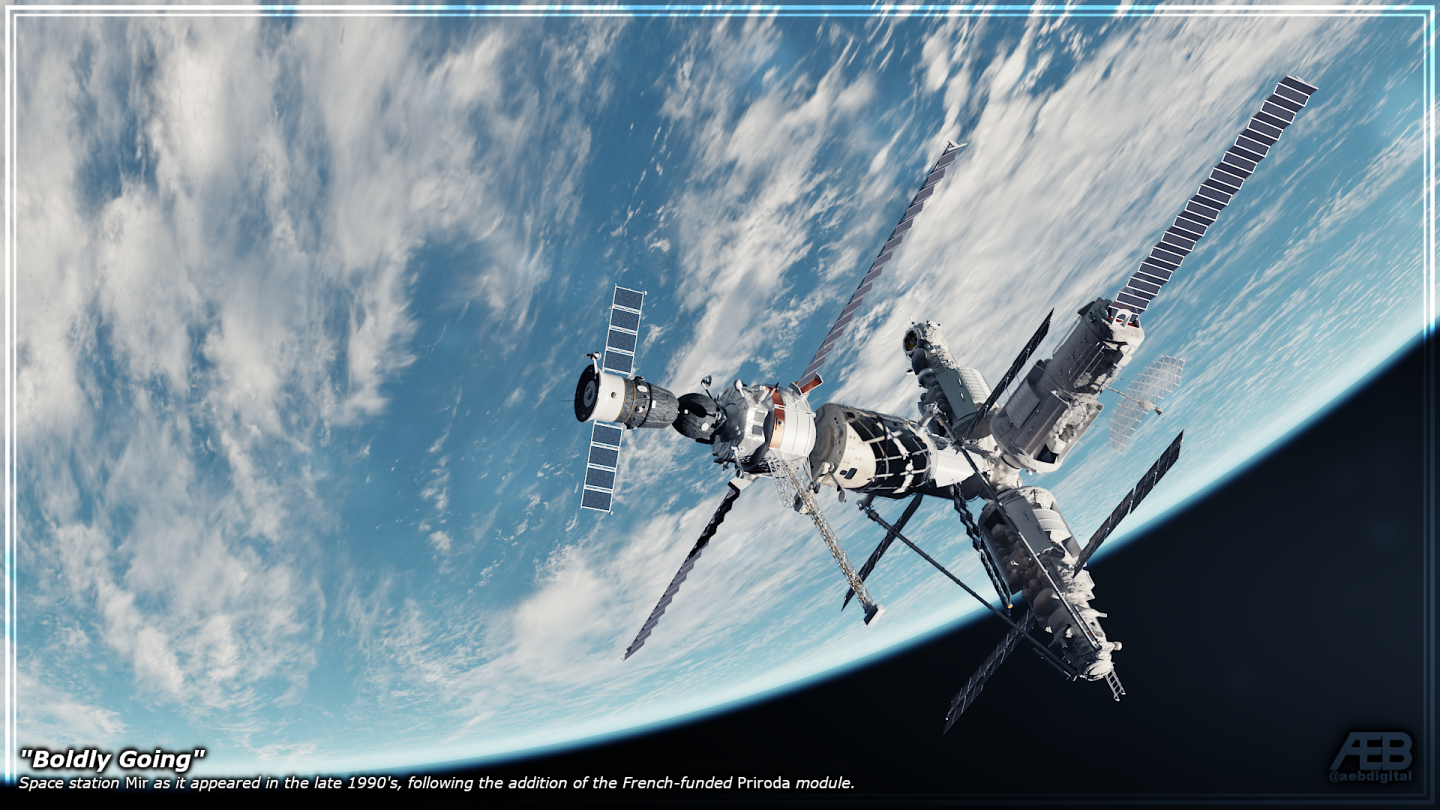
The French flights to Mir, by contrast, were not short duration visits by any means, but instead an ongoing project demonstrating European independence from NASA planning. As a result of CNES’s frustrations with deferred American station planning in the early part of the decade, the late 1990s saw the launch of the station’s Priroda laboratory, one of the originally planned TKS-based lab modules which was completed and launched thanks to CNES funding. In exchange for the module’s funding, France received several experiment spots aboard the station, which were then visited by a succession of French astronauts aboard Russian Soyuz capsules embedded with long-duration Mir crews, some of whom had previously flown aboard Shuttle or Space Station Enterprise. Those which had not already done so before flying to Mir were likely to do so after, given the demand for crew during the busy period outfitting the LOX tank Habitat Module aboard Enterprise between 1995 and 1997. Mir’s facilities were limited, even for the crews of 3 typically aboard, and even two Russian exchange astronauts who visited Enterprise aboard STS-95 during 1997 had to concede that the incomplete Enterprise still offered larger crew spaces and more capability for hosted experiments. While the new Habitat Module was more spacious, some areas like the “hamster tubes'' were nearly as cramped as their equivalents aboard Mir. Still, unlike Mir, Enterprise was growing, and the new laboratories would be a major step forward in capability, helping to justify the expanded crew habitat spaces and power generation facilities.
The challenge lay in getting those new modules launched as the lunar program ramped up. Enterprise’s first-and-only launch from Kennedy Space Center had required the activation of a third High Bay in the Vehicle Assembly Building, meaning that NASA had the ability to stack three STS launchers at the same time, whether those be conventional Space Shuttles or the new Shuttle-C. Consideration was given to activating the VAB’s fourth High Bay, bringing it to a level of capability never even seen during Apollo. Ultimately it was decided to be too costly to be worth the expense, given the need to have someplace in or near the VAB for vertical checkout of External Tanks newly arrived in Florida. Besides, pad utilization limits would have allowed only a small boost in launch rates from four integration cells before new limits were imposed by launch site availability [1]. However, the requirement to have a rescue orbiter available for launch-on-need for any missions not going to an orbit at least coplanar with Space Station Enterprise meant that in practice there was only room for one of the new Shuttle-C launch vehicles to be prepared at a time if a Space Shuttle launch was to happen within the next month or so. Two Shuttle-C launches were required for a 2-person, 4-day sortie mission to the moon, and a full four launches would be required in two campaigns for more-extended 4-person, multi-month “mini-base” missions. Even testing these procedures required cutting large gaps into the Space Shuttle launch cadence, Thus, NASA mission planners had to carefully balance the requirements and timing for test flights of Shuttle-C and lunar hardware, science missions and payload deployment missions by the Space Shuttle not headed to Enterprise, and Space Shuttle launches carrying crew, supplies, or new modules to Enterprise.
The effect was like trying to keep three or four plates spinning on the ends of rods--every plate needed to be refreshed as it spun down, but little more attention could be paid to each than the bare minimum. If any program was “first among equals,” it was the lunar program. Even with the replacement of President George H. W. Bush with President Clinton, the multinational lunar program proceeded with a high level of priority. Though unofficial, almost all of NASA and the political atmosphere surrounding the agency continued to place a high value on the return to the moon happening in time for the 30th anniversary of the Apollo landings in 1999. When originally authorized by Congress in 1991, it had been expected that the Shuttle-C vehicle could draw on the legacy of Enterprise’s launch on STS-37R to target a 1996 introduction into service, allowing extensive time for testing ahead of the debut of lunar hardware. Unfortunately and perhaps unsurprisingly, the scope of the vehicle had increased to match the time allowed before the first lunar landers and lunar-bound Kepler spacecraft would be available.
Artwork by: @nixonshead (AEB Digital on Twitter)
[1] Typical timing for a Shuttle mission in the mid-90s historically, taken from data in Jenkins (III-410 to III-413):
SRB stacking typically took 18 to 21 days, during which much other work in the entire VAB must be stopped, notably including prep for ET or Orbiter mate in other cells. ET mate and preparation for orbiter mate appears to have been about a week, although this was often interrupted by SRB segment stacking for other, later, flights and would result in pauses measured in weeks or months between SRB stacking and ET and orbiter-mate. Orbiter mate to rollout was often about a week. Time on the pad prior to launch was typically about 24 to 35 days, excluding particularly protracted stays. This gives about 6 weeks total in the VAB, for about 17 per year as a theoretical maximum, though @TimothyC has a recollection a practical limit was considered more like 14/year (from Shuttle and Shuttle-C study work in the late 1980s and early 1990s). This matches with the rough time in the Orbiter Processing Facility (~60-100 days) which limits each orbiter to closer to 4 flights per year, for about 12-16 for the fleet.
With LRBs and Shuttle-C slotting in, those limits change a lot. It’s about three weeks in the VAB, with no limits on work in adjacent cells, meaning three VAB cells can generate about 50 flights/year, in theory. In practice, that number would be lower, but even with two launch pads, a flight every 35 days per pad is still only about 28 flights per year meaning pads, and more specifically MLPs, and not VAB cells, is the new limit.
As far as @TimothyC sees, the fastest turn around of a launch pad in the program history was 410 hours (just over 17 days) between the launches of STS-51-D and STS-51-B in April of 1985. Given that the pad infrastructure needed to be checked after each exposure to the SRB exhaust, this can be treated as the fastest a pad (but not an MLP) can be turned around. The stack used on STS-51-B had been prepared for the STS-51-E Mission in March of 1985, but was rolled back to the VAB due to concerns with the planned TDRS-IUS payload. A payload that would eventually be remanifested on STS-51-L both OTL, and ITTL. LRB exhaust reduces the wear to the MLPs, though not to a degree where we can quantify the upper limits.
There’s still only about 12-16 Orbiter availabilities per year, but Shuttle-C would be able to fly another 3-4 flights per year per reusable OPAM. The core of all this, then, is that with Shuttle-C added to the Shuttle rotation and LRBs significantly reducing time in the VAB, STS can support pretty much any flight rate NASA can afford to utilize, well into the double digits, as long as a significant number of them are Shuttle-C.
After taking over command of the station, the second permanent crew of Space Station Enterprise settled into their new home. The work of outfitting the LOX tank continued to consume the crew’s time as a top priority. The early Enterprise expeditions were well-motivated, as they were literally building their new home. Until the new habitat section was complete, they continued to bunk in the Shuttle-adapted sleep stations in OV-101’s middeck, which also served as galley and was home to the station’s only lavatory. This additional space had seemed vast when some expedition crews had previously used them when visiting the station short-term aboard Shuttle flights...when they had the benefits of an entire second Orbiter’s middeck, lavatory, and typically another Spacelab or Spacehab module. With no second orbiter beyond the intertank’s docking hatch, the crew of four had barely more space than any pre-Enterprise Space Shuttle mission, but were now embarked aboard for a mission months in duration. The counterbalance of the massive open LOX tank volume was cited by many of the crew as key ammunition against cabin fever given the cramped confines of their existing habitat in the old orbiter portion of the station, even as it consumed workday after workday.
[Note: Images in this section are rescaled down. Click on them for links to full size]

The arrival of STS-83 in June 1996 was a welcome relief for Expedition 2 both from the cramped confines of the primary habitat spaces and from the daily routine of assembling hardware and tracking down loose bolts inside the LOX tank. The orbiter brought with it the first permanent addition to the station, the Japanese-built Node 1 module. Fitted with an APAS port at each end and four radial CBM ports, this module once attached to the nadir port on the station’s intertank would be the core of the nadir ISPR section of the station. There, it would eventually host the new European and Japanese laboratories which were still under construction. In addition to this role in future growth, Node 1 also served a critical immediate need which was highlighted by the complexity of its own arrival. At launch, Space Station Enterprise had just two APAS ports. With one taken up by Shuttle and one by the current Kepler lifeboat, there was neither room to rotate crew return vehicles, nor a place to lock the larger new Multi-Purpose Logistics Modules (MPLMs) which Europe was building for Shuttle logistics flights. In the meantime, Spacelab and the commercial Spacehab modules had to suffice, with cargo brought through the Shuttle’s APAS docking port. The issue was that Shuttles arriving at station docked to the adapter on the same nadir intertank port which Node 1 was intended to dock to. Thus, a complex ballet was required for Challenger to deliver the new Node. Before arriving at the station, Challenger’s crew extracted the node and pre-docked the future zenith end to the Shuttle’s docking port, and then flew the node into docking at the nadir end of the existing adapter in one of the trickier docking maneuvers of the Shuttle program’s history. During STS-83’s short stay on the station, only limited work was done to set up the new module. Once the Shuttle left, Expedition 2 were then free to disconnect the zenith end of the existing adapter from the intertank’s APAS port. Using CanadArm 2, the station then flipped the adapter-and-Node subassembly end-for-end and reattached it. Node 1 was thus in its final configuration, and then the adapter module was detached from Node 1 and flipped again. This complex “Towers of Hanoi” puzzle left the adapter once more right-side-up, but now at the nadir end of Node 1, ready to receive the next orbiter and with 4 more ports open on the sides of Node 1.
[Note: Images in this section are rescaled down. Click on them for links to full size]


Comparing the relatively small number of crew-hours required to finish installing and outfit the new Node 1 with the much large number required to build the LOX tank habitat in-situ provided major ammunition to those recommending against the incorporation of wet-lab tank adaption into future projects, primarily on the Moon but also for future missions to Mars or beyond. However, advocates of those techniques also pointed out that while the outfitting process would end up consuming the complete attention of five Enterprise Expeditions between August 1995 and May 1997, the result was a station which could barely have been launched any other way. Over roughly a year and a half, the vertical columns and hand-grip wires spanning the cavernous tank had turned into decks, then the framing that defined future walls. Much like building a house on Earth, those frames had been filled by a complex and well-thought-out maze of wiring, plumbing, and ducts. With the labyrinth of utilities installed, the partition walls had been finished by adding their outer foam board and fabric coverings, then stowage racks, equipment bays, and furniture had been installed into the newly divided spaces. By the spring of 1997, the new module’s basic life support systems were active and the crew were sleeping inside the former LOX tank, with the expanded crew quarters allowing Expedition 4 to be augmented to become the first 8-person crew aboard the station with the arrival of four more crew members who would rotate on into Expedition 5. The jump in available hands and the morale benefits of rapidly approaching completion helped accelerate the process, and the work inside the LOX tank was largely done by the time Expedition 5 took over the station in the summer of 1997.
The laborious work of outfitting the Enterprise Habitat Module inside ET-007’s former LOX tank was only part of the work carried out to ready the station for expansion in 1997. In addition to work inside the station’s pressure volume, Expedition 5’s expanded crew also conducted EVAs to run some of the external cabling for the new port and starboard truss modules to their future mounting points on either side of the intertank. This productivity was driven, in part, by the fact that the additional personnel had little scientific work competing for their attention. The station’s lab equipment was still contained in the single Leonardo Lab Module, by 1997 as often known by crews as the “Old Lab” as by the acronym “LLM” or the former slang term “LeoLab.” When the truss modules, and the labs whose power systems they would support arrived over the next two years, Space Station Enterprise would once again raise the bar for orbital outpost capabilities. In the meantime, the crew had little to compete with their day-to-day tasks of tending a few experiments, routing cables, assembling furniture and exercise equipment, and testing systems. Their recreation options had expanded tremendously in the new Enterprise Habitat Module, and Space Station Enterprise became known as a place which worked hard, but also played hard. Beyond a robust litany of pranks played within the crew, on ground control, and visiting Shuttles, the crew enjoyed swapping stories in the galley, and also a long list of higher technology entertainments. The crew could watch movies and television recordings on the station’s new VHS video player, which although intended partially for training was recognized as a critical entertainment device to prevent boredom on long rotations. Tapes of Hollywood films, recent television, and sports events were prime fodder for the on-station barter economy when Space Shuttle crews visited. They could also enjoy a limited selection of board games, listening to music on compact disc, and making their own music with the station’s collection of musical instruments. Even the station’s collection of laptops, primarily intended for updating schedules and reviewing documents, could be used for playing games like Minesweeper, Solitaire, and Microsoft’s ubiquitous “Space Cadet” pinball.
The outfitting of the new habitat module and the cycling of permanent crews also began to build up new collections of decorations. “Hoot” Gibson’s two posters had been joined by other wall decorations, ranging from posters of Hubble Space Telescope images to the mission patches of various Enterprise expeditions and Shuttle missions which had visited the station. The roof of one of the longitudinal hallways past the crew quarters on the main deck was graced by dueling posters of the crews of the Enterprise from the original series and Star Trek: The Next Generation. An attempt to replicate Skylab crew’s practice of running laps around the station’s diameter in the large forward exercise bay and the aft translational dome of the habitat module brought reprimands for the crew of Expedition 6, as it disturbed the microgravity of experiments aboard the station. While the vibrations of assembly and outfitting were tolerable as long as it happened, they had to be minimized now that the station’s plush new habitat was finally largely complete.
The luxurious new accommodations and amenities drew rave reviews from crew aboard the station. During the mid-to-late 90s, several astronauts within NASA’s corps and much of ESA’s French astronaut complement had the chance to fly to the Mir space station. The Americans made their visits aboard the Space Shuttle during the Shuttle-Mir Program, a series of short-duration visits of the Space Shuttle to the Russian space station which were in many ways a follow-up to the Apollo-Soyuz Test Project. The flights, and equivalent exchange flights of Russian cosmonauts to Enterprise for short duration stays on the station, were aimed at enhancing relations with the post-Soviet Russian Federation and ensuring none of their rocketry experience leaked into the hands of rogue states.
[Note: Images in this section are rescaled down. Click on them for links to full size]

The French flights to Mir, by contrast, were not short duration visits by any means, but instead an ongoing project demonstrating European independence from NASA planning. As a result of CNES’s frustrations with deferred American station planning in the early part of the decade, the late 1990s saw the launch of the station’s Priroda laboratory, one of the originally planned TKS-based lab modules which was completed and launched thanks to CNES funding. In exchange for the module’s funding, France received several experiment spots aboard the station, which were then visited by a succession of French astronauts aboard Russian Soyuz capsules embedded with long-duration Mir crews, some of whom had previously flown aboard Shuttle or Space Station Enterprise. Those which had not already done so before flying to Mir were likely to do so after, given the demand for crew during the busy period outfitting the LOX tank Habitat Module aboard Enterprise between 1995 and 1997. Mir’s facilities were limited, even for the crews of 3 typically aboard, and even two Russian exchange astronauts who visited Enterprise aboard STS-95 during 1997 had to concede that the incomplete Enterprise still offered larger crew spaces and more capability for hosted experiments. While the new Habitat Module was more spacious, some areas like the “hamster tubes'' were nearly as cramped as their equivalents aboard Mir. Still, unlike Mir, Enterprise was growing, and the new laboratories would be a major step forward in capability, helping to justify the expanded crew habitat spaces and power generation facilities.
The challenge lay in getting those new modules launched as the lunar program ramped up. Enterprise’s first-and-only launch from Kennedy Space Center had required the activation of a third High Bay in the Vehicle Assembly Building, meaning that NASA had the ability to stack three STS launchers at the same time, whether those be conventional Space Shuttles or the new Shuttle-C. Consideration was given to activating the VAB’s fourth High Bay, bringing it to a level of capability never even seen during Apollo. Ultimately it was decided to be too costly to be worth the expense, given the need to have someplace in or near the VAB for vertical checkout of External Tanks newly arrived in Florida. Besides, pad utilization limits would have allowed only a small boost in launch rates from four integration cells before new limits were imposed by launch site availability [1]. However, the requirement to have a rescue orbiter available for launch-on-need for any missions not going to an orbit at least coplanar with Space Station Enterprise meant that in practice there was only room for one of the new Shuttle-C launch vehicles to be prepared at a time if a Space Shuttle launch was to happen within the next month or so. Two Shuttle-C launches were required for a 2-person, 4-day sortie mission to the moon, and a full four launches would be required in two campaigns for more-extended 4-person, multi-month “mini-base” missions. Even testing these procedures required cutting large gaps into the Space Shuttle launch cadence, Thus, NASA mission planners had to carefully balance the requirements and timing for test flights of Shuttle-C and lunar hardware, science missions and payload deployment missions by the Space Shuttle not headed to Enterprise, and Space Shuttle launches carrying crew, supplies, or new modules to Enterprise.
The effect was like trying to keep three or four plates spinning on the ends of rods--every plate needed to be refreshed as it spun down, but little more attention could be paid to each than the bare minimum. If any program was “first among equals,” it was the lunar program. Even with the replacement of President George H. W. Bush with President Clinton, the multinational lunar program proceeded with a high level of priority. Though unofficial, almost all of NASA and the political atmosphere surrounding the agency continued to place a high value on the return to the moon happening in time for the 30th anniversary of the Apollo landings in 1999. When originally authorized by Congress in 1991, it had been expected that the Shuttle-C vehicle could draw on the legacy of Enterprise’s launch on STS-37R to target a 1996 introduction into service, allowing extensive time for testing ahead of the debut of lunar hardware. Unfortunately and perhaps unsurprisingly, the scope of the vehicle had increased to match the time allowed before the first lunar landers and lunar-bound Kepler spacecraft would be available.
Artwork by: @nixonshead (AEB Digital on Twitter)
[1] Typical timing for a Shuttle mission in the mid-90s historically, taken from data in Jenkins (III-410 to III-413):
SRB stacking typically took 18 to 21 days, during which much other work in the entire VAB must be stopped, notably including prep for ET or Orbiter mate in other cells. ET mate and preparation for orbiter mate appears to have been about a week, although this was often interrupted by SRB segment stacking for other, later, flights and would result in pauses measured in weeks or months between SRB stacking and ET and orbiter-mate. Orbiter mate to rollout was often about a week. Time on the pad prior to launch was typically about 24 to 35 days, excluding particularly protracted stays. This gives about 6 weeks total in the VAB, for about 17 per year as a theoretical maximum, though @TimothyC has a recollection a practical limit was considered more like 14/year (from Shuttle and Shuttle-C study work in the late 1980s and early 1990s). This matches with the rough time in the Orbiter Processing Facility (~60-100 days) which limits each orbiter to closer to 4 flights per year, for about 12-16 for the fleet.
With LRBs and Shuttle-C slotting in, those limits change a lot. It’s about three weeks in the VAB, with no limits on work in adjacent cells, meaning three VAB cells can generate about 50 flights/year, in theory. In practice, that number would be lower, but even with two launch pads, a flight every 35 days per pad is still only about 28 flights per year meaning pads, and more specifically MLPs, and not VAB cells, is the new limit.
As far as @TimothyC sees, the fastest turn around of a launch pad in the program history was 410 hours (just over 17 days) between the launches of STS-51-D and STS-51-B in April of 1985. Given that the pad infrastructure needed to be checked after each exposure to the SRB exhaust, this can be treated as the fastest a pad (but not an MLP) can be turned around. The stack used on STS-51-B had been prepared for the STS-51-E Mission in March of 1985, but was rolled back to the VAB due to concerns with the planned TDRS-IUS payload. A payload that would eventually be remanifested on STS-51-L both OTL, and ITTL. LRB exhaust reduces the wear to the MLPs, though not to a degree where we can quantify the upper limits.
There’s still only about 12-16 Orbiter availabilities per year, but Shuttle-C would be able to fly another 3-4 flights per year per reusable OPAM. The core of all this, then, is that with Shuttle-C added to the Shuttle rotation and LRBs significantly reducing time in the VAB, STS can support pretty much any flight rate NASA can afford to utilize, well into the double digits, as long as a significant number of them are Shuttle-C.
Last edited:
Part 17 Image Annex: LOX Tank Interior
Boldly Going Part 17 Image Annex
Images by @nixonshead (AEB Digital on Twitter) showing off the interior of the LOX Tank after conversion to habitation space. Images in this annex are reduced in size, so click on them for links to the full size renders!
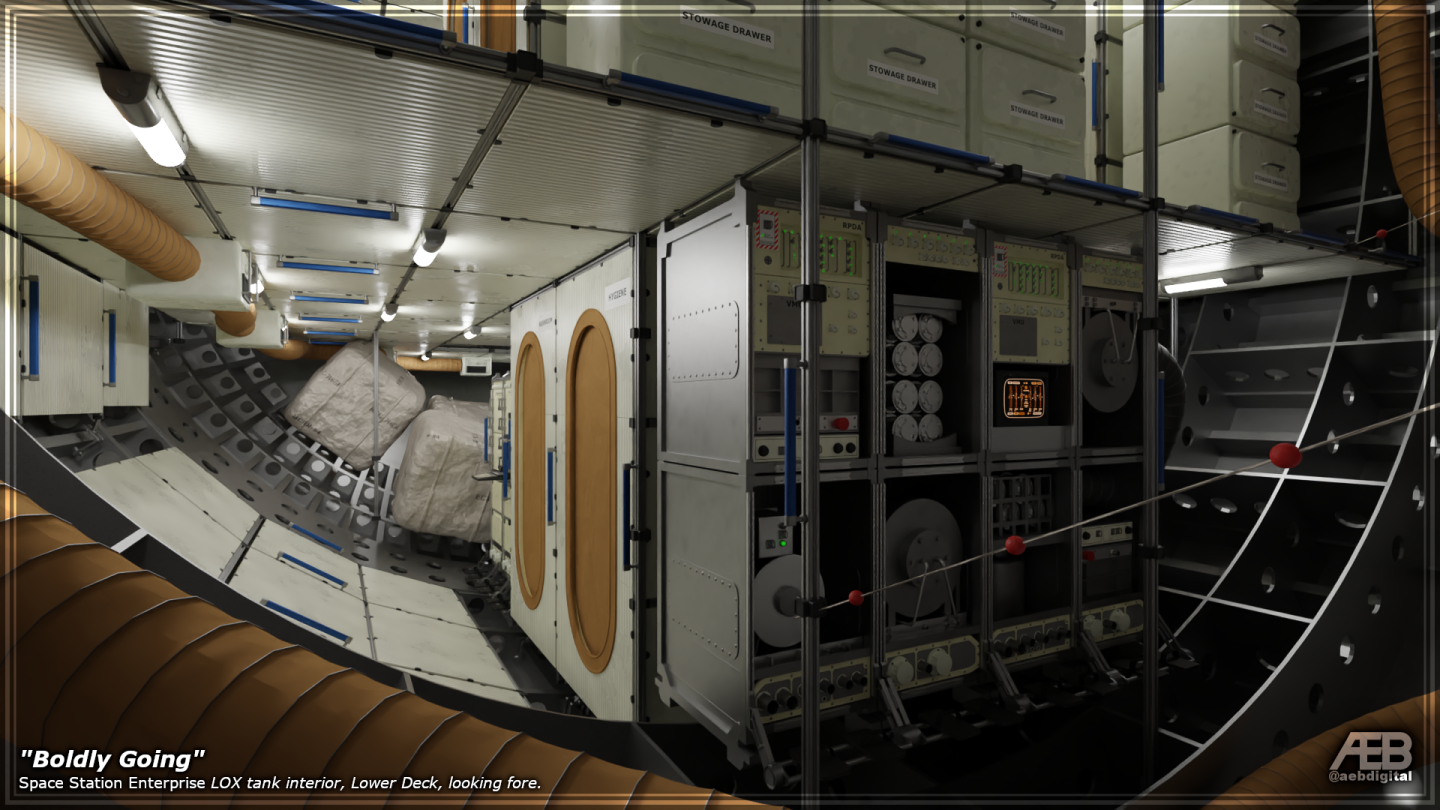
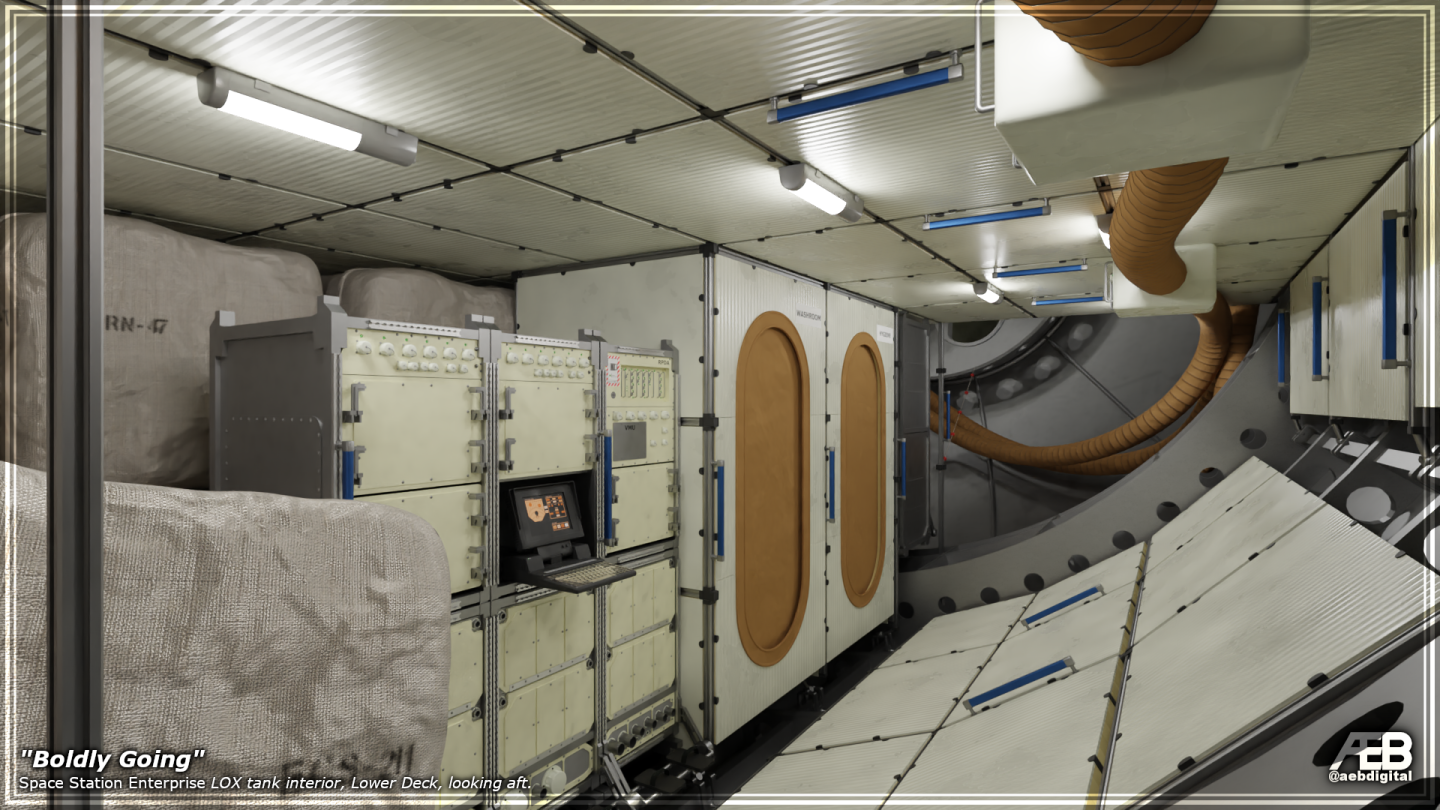
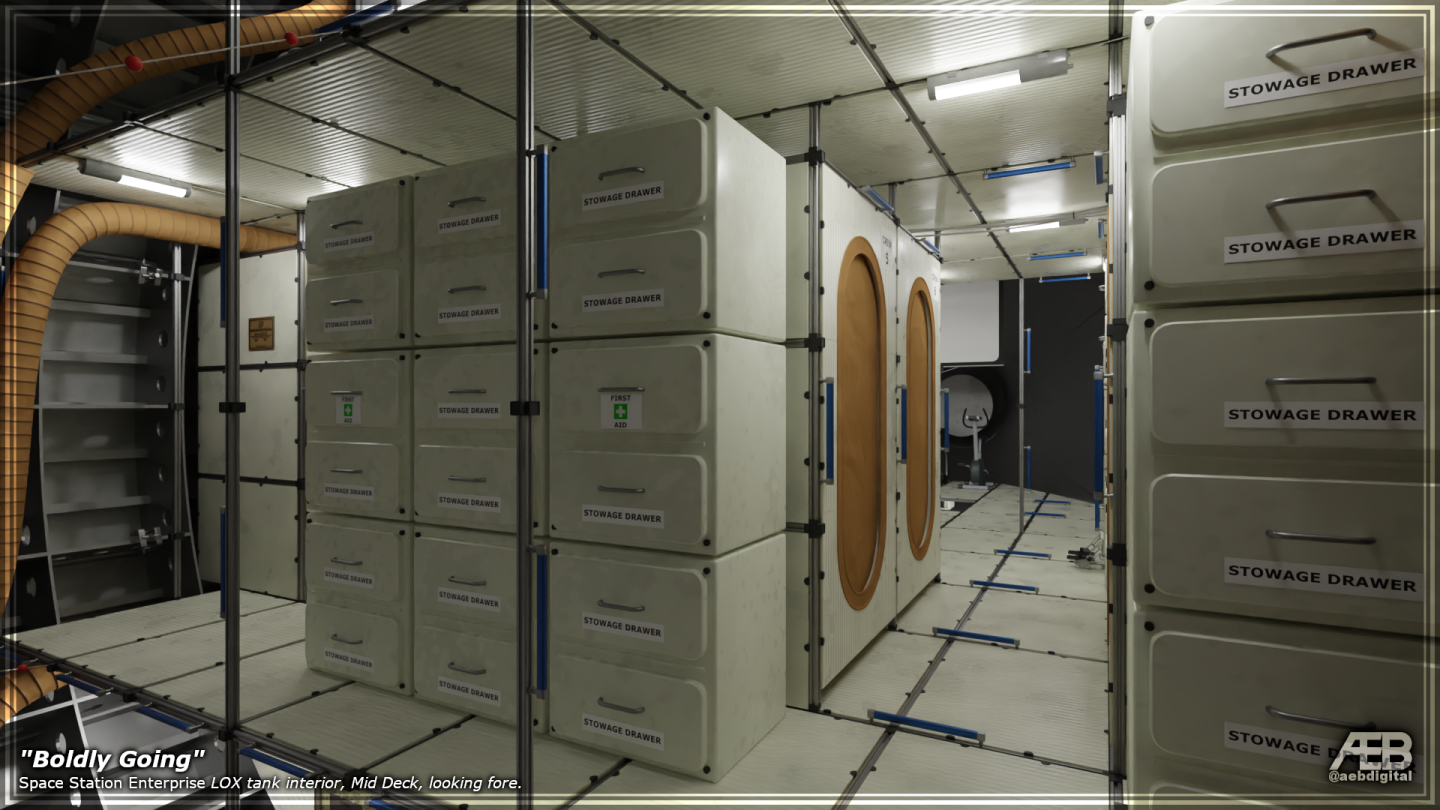
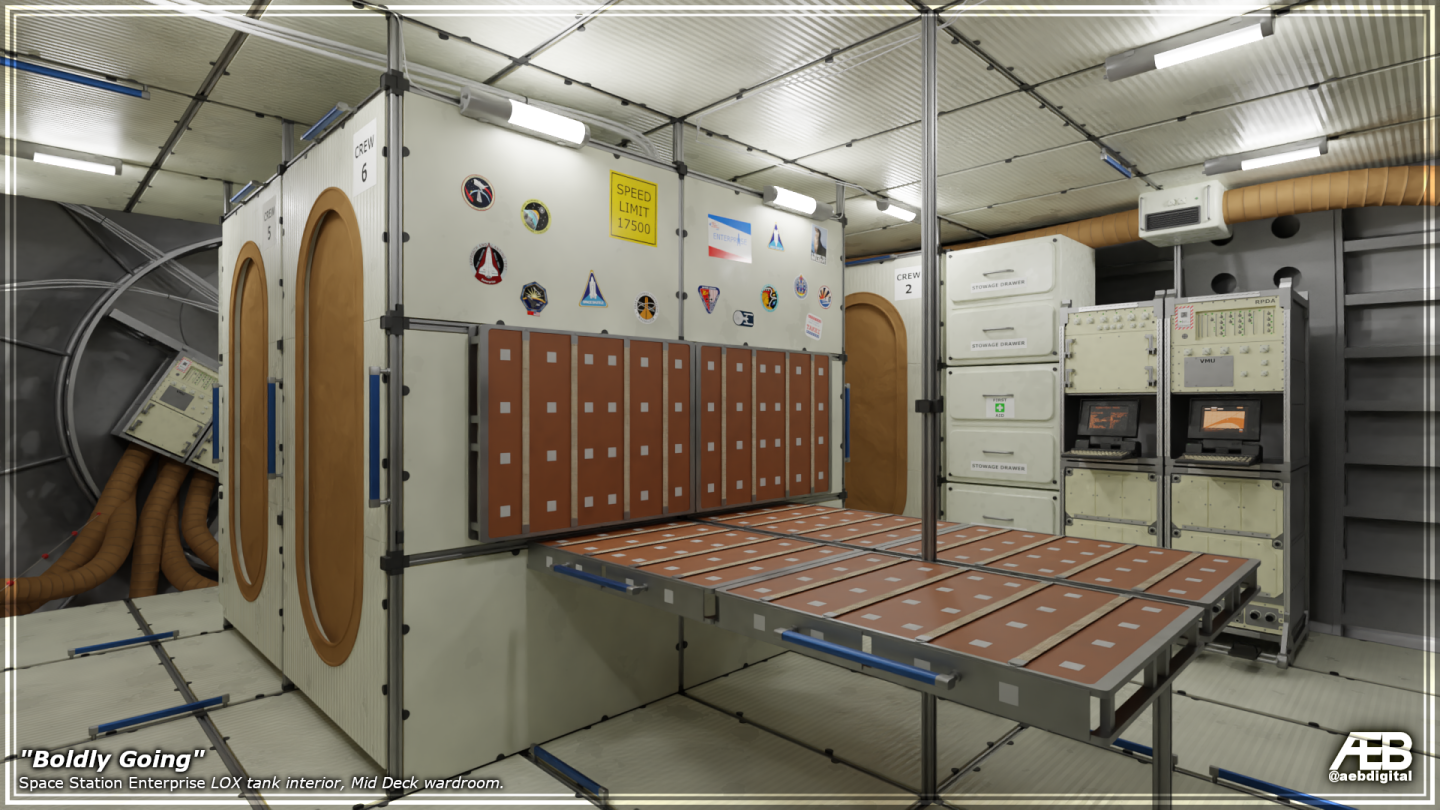
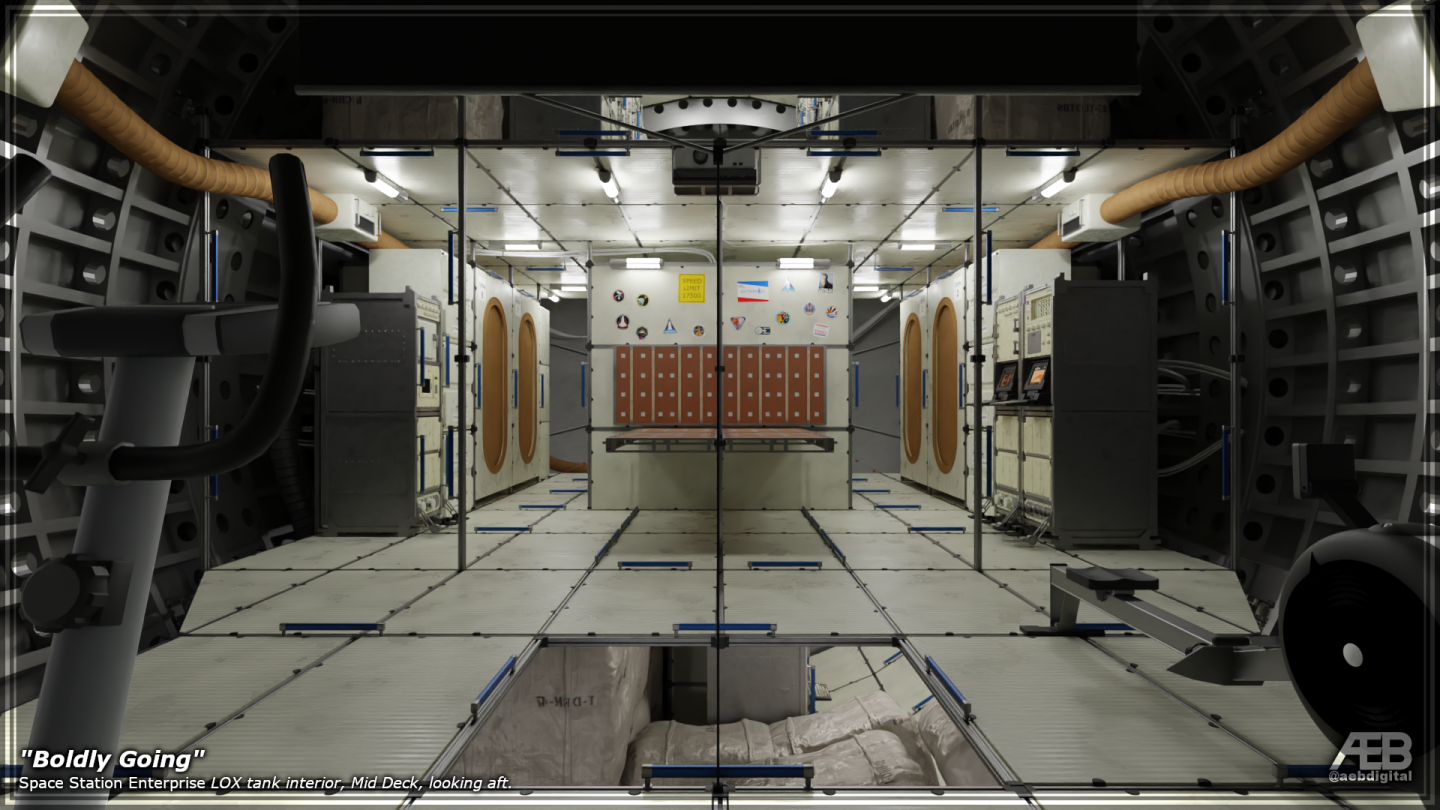
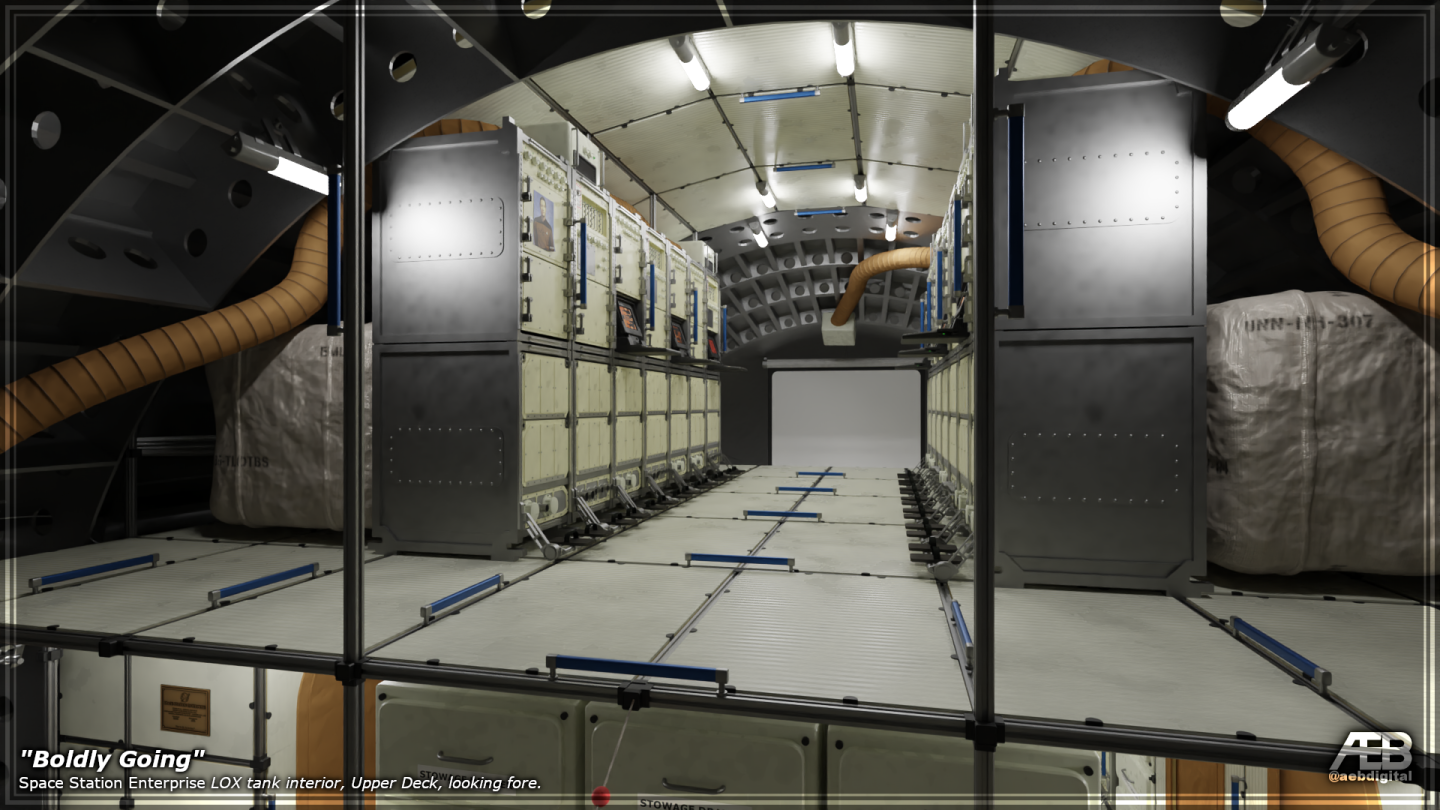

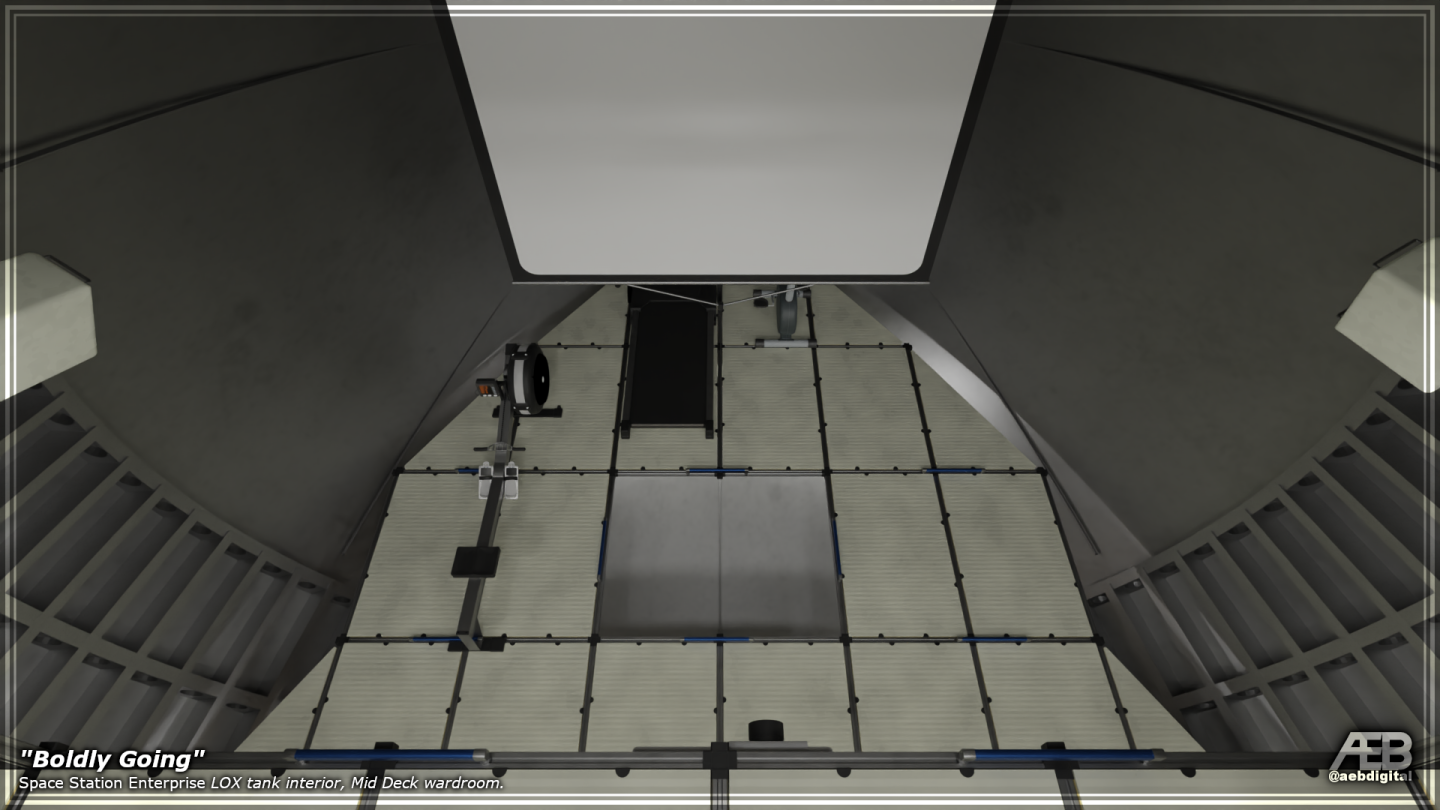

Images by @nixonshead (AEB Digital on Twitter) showing off the interior of the LOX Tank after conversion to habitation space. Images in this annex are reduced in size, so click on them for links to the full size renders!









Last edited:
Will there be new types of Shuttles eventually in this TL. The OTL Shuttle pisses me off lol (mostly because of missed potential)
Excellent art, as always. Reminds me of the Skylab II mock-up at MSFC a few years ago. VHS video player--probably on tiny screens, though, this being the 1990s. Pity the LH2 tank isn't pressurized--projecting films onto the aft dome (or a screen stretched across it) would be more popular.
Look at the second to last image in the annex.Excellent art, as always. Reminds me of the Skylab II mock-up at MSFC a few years ago. VHS video player--probably on tiny screens, though, this being the 1990s. Pity the LH2 tank isn't pressurized--projecting films onto the aft dome (or a screen stretched across it) would be more popular.
Ah, now I understand it!Look at the second to last image in the annex.
It even has some genuine scientific value. If you want to do, say, a microgravity combustion or fluid dynamics experiment, a neutral white background for videorecording or Schlieren imaging is useful.
Threadmarks
View all 43 threadmarks
Reader mode
Reader mode
Recent threadmarks
Part 32: The headaches and hassles of developing the next generation of reusable systems - Diana & Shuttle II Part 33: First and Last. Enterprise outlasts its sisters. Shuttle-II flight tests and epilogue. author's note: e of pi author's note: TimothyC Author's Notes: Vehicle Names Author's Notes: World Space Programs Author's Notes: Disposition of Shuttle Program Hardware 2022 Turtledove Win Thanks
Share: